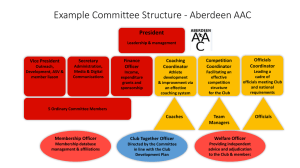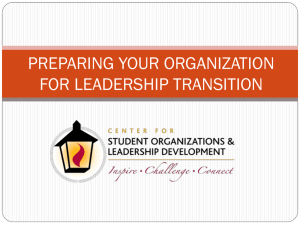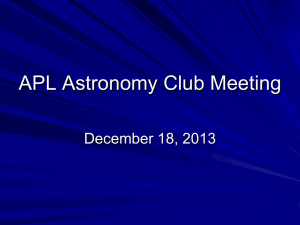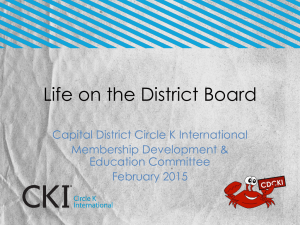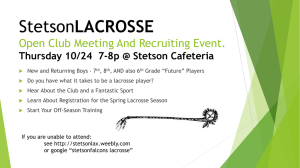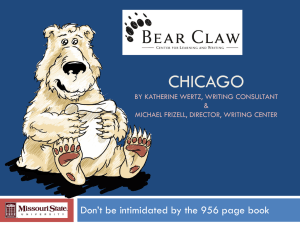Committee Structures & Roles Presentation
advertisement
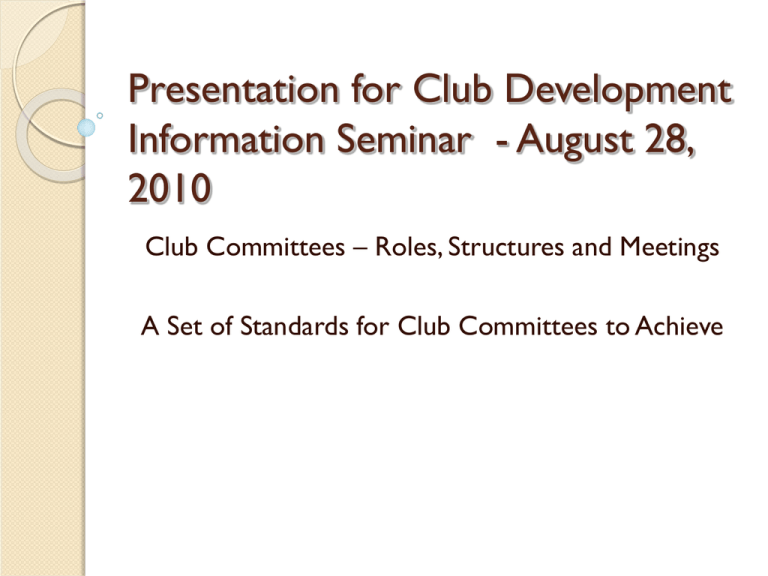
Presentation for Club Development Information Seminar - August 28, 2010 Club Committees – Roles, Structures and Meetings A Set of Standards for Club Committees to Achieve You will: Review your club committee against nine indicators, including relevant roles, structure, policies and effective meetings Hear relevant information that can help you achieve those goals if your committee is not meeting them currently Create a plan of action for your club committee Indicator One We have a club constitution in accordance with the official guidelines of the sporting authority to which we are affiliated and every person on our committee has read this constitution… Many associations have guidelines for writing club constitutions See www.gaa.ie Go to “club information” section and look for club constitution that you can download See www.irishrugby.ireland.ie “Club and community” section See www.athletics.ireland.ie “Clubs” go to “sample club constitution Use any of these as a guide if your association does not have one Go to www.irishsportscouncil.ie for a complete list of governing bodies This document needs to be kept “live” – take it out and read it once a year Indicator Two We elect our committee in accordance with the guidelines of the relevant authority, including ensuring that no-one is on the committee longer than they are supposed to be... Look to the associations for guidance Your club constitution should contain this information. Includes: election to committee, number of meetings per year, structure of committee, length of tenure for appointment to committee etc. Indicator Three All the committee members understand the role of a committee and their individual role… The role of a committee is: Developing plans for the club Guaranteeing club’s financial health including approving annual budget Ensuring enough volunteers to run the club and that the club is a positive place to volunteer Making sure legal requirements are followed Writing policies to guide the operation of the club Working effectively together in order to run a successful club Carrying out administration Setting up sub-committees to undertake financial, personnel, fundraising and planning functions Having good links with the community and partner agencies The role of an individual member is: Understanding the club’s work Knowing the committee’s legal obligations Making sure the board’s legal obligations are followed Understanding financial and budget issues. Attending meetings and participating in the work of the club Indicator Four We have nominated a chair, secretary, treasurer, registrar and a children’s officer (at the least) and they each have a clear written role description… Structure of a Club Committee Different associations have different guidelines around these. Go to your association’s website. Other officer roles include: volunteer coordinator, public relations, transport, culture and language, player’s representative, ASAP Officer Chair/ Vice Chair: Delegates tasks and responsibilities to relevant volunteers, does support and supervision with volunteer officers, may run the committee meetings, ensures regular review of the club’s work, devises agendas for the committee meeting Roles continued.. Secretary: takes meeting minutes, does any administrative work for the group, including mail-outs, phone calls etc, schedules meeting spaces and other logistics for the club Registrar: keeps registration lists for club participants and volunteers Treasurer: keeps track of the accounts for the group, doing any returns and accounting necessary Role descriptions Each Officer needs a role description so that they are aware of their specific responsibilities Headings in role description: title; purpose; responsible to; main tasks Indicator Five We properly recruit and induct all new committee members… Committee Induction Includes Interviewing of potential member to assess their skills and interests and appropriateness for committee Garda vetting Review of the constitution and outline legal requirements of board Review of the volunteer policy Review of responsibilities of board, individual members and specific Officer roles Indicator Six We have regular committee meetings (including an AGM), with good attendance that result in accurate minutes, signed and kept in a minute book Running effective meetings Problems with attendance need to be addressed by the Chair If attendance is generally poor there are underlying issues with the group that will need to be explored. Is there a problem with group dynamics? Follow the guidelines for effective meetings (see handouts) Follow the guidelines for effective chairs (see handouts) Taking Minutes Do not record every discussion in detail, just enough so that someone who was not there could understand what was discussed, ie pros and cons for support of something and any agreement or actions resulting Record points not the people that said them (unless requested to do so) Record key agreements and actions. Minutes from previous meetings need to be adopted at the next meeting Headings for minutes: title, present, apologies, adoption of minutes of previous meetings, matters arising, agenda item headings, AOB, date of next meeting Indicator Seven We review our committee membership for the skills, knowledge and experience we need… Having the Right Skills Have a regular review of the different skills needed on a committee: financial, communications, partnership working, sports, human resources, leadership Ensure there is someone to match each skill set on the committee If not, look at recruitment of new committee members using a targeted approach: going to local businesses, organisations etc. Indicator Eight We have developed written policies necessary for the club: volunteer, financial, child protection, health and safety… Guidance for policy development Create a sub-committee to carry out work on specific policies Child protection: check with your association. See www.childprotection.ie Headings for a Policy: Name of Policy, Policy Statement (a broad statement of commitment to the policy area and why it is important), Principles (informing the implementation of the policy), Scope (who and what programmes/ services the policy is applicable to) Responsibility (who is assigned responsibility for ensuring the policy is followed), Definitions (of key concepts relevant to the policy if necessary), Policy (this is process or steps for implementation of the policy – how do you go about implementing the commitment?) Legal Parameters (any laws/ acts relevant to the policy), Related Documents (any other policies or written documents that are relevant to the policy) See Volunteers Centre Ireland. “Developing a Volunteer Policy for your Organisation – a Step by Step Guide.” www.volunteer.ie Indicator Nine When necessary, we set up subcommittees to carry out specific pieces of work for the club… Sub-committees Smaller groups of members of the club committee (and sometimes other volunteers in the club) who come together to carry out pieces of work or functions of the larger committee for a variety of reasons, such as: ◦ Finance – to ensure that the committee is reaching the highest standard of financial accountability and that the proper policies and procedures are in place ◦ Fundraising – to ensure that the club has a secure resource base and to plan specific fundraising activities ◦ Governance – to plan how the overall club committee will work, ie to put policies and procedures in place for this ◦ Specific projects/ initiatives – where the club engages in a specific piece of work a group might form to oversee this process You know a committee is in trouble when There is lots of turnover of committee members/ volunteers and chairs. Its hard to recruit good committee members There is bad attendance or participation at meetings Conflict/ tension is not being addressed Communication/ relationships with funding agencies and stakeholders/ community are poor. (CUPE National Research Branch. “Social Services: a Guide to Non-Profit Governance.” CUPE: Canada.)

